Mover seu site WordPress para um novo domínio é uma grande etapa que exige um planejamento cuidadoso. Alterar seu nome de domínio pode afetar suas classificações de SEO, portanto, é essencial lidar com o processo com cuidado.
Já passamos pelo processo de mudança de domínio várias vezes, portanto, conhecemos em primeira mão as possíveis armadilhas e sabemos como evitá-las.
Embora as flutuações temporárias de SEO sejam inevitáveis durante uma migração de domínio, você pode reduzir o impacto. Com a abordagem correta, você poderá recuperar rapidamente o tráfego de pesquisa e as classificações.
Neste guia, vamos orientá-lo sobre a maneira correta de mover o WordPress para um novo domínio sem perder o SEO.
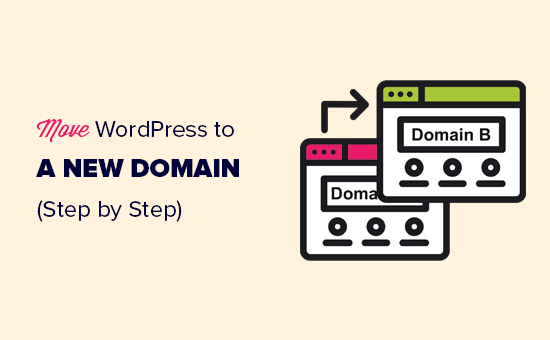
Migrar seu site WordPress para um novo nome de domínio pode ser assustador, mas não precisa ser. Estamos aqui para orientá-lo em todas as etapas do processo.
Você pode clicar em qualquer um dos links abaixo para ir para uma etapa específica da migração do seu site WordPress para um novo nome de domínio:
- What to Know Before You Change Domains
- Pre-Steps: What You Need to Get Started
- Step 1: Create a Duplicator Package of Your WordPress Site
- Step 2: Create a Database for Your New Domain Name
- Step 3: Unpack WordPress on Your New Domain Name
- Step 4: Set Up Permanent 301 Redirects
- Step 5: Notify Google About Your New Domain
- Notify Your Users About the New Domain Name
- Video Tutorial
O que saber antes de mudar de domínio
Antes de começar, há algumas coisas que você deve saber.
O processo de transferência para um novo domínio afetará temporariamente as classificações do seu mecanismo de pesquisa, pois o Google e outros mecanismos de pesquisa precisarão se ajustar às alterações.
Isso também afetará temporariamente seu tráfego de pesquisa. Lembre-se de que isso é normal e acontece com todos os sites que mudam para um novo domínio.
No entanto, você pode reduzir drasticamente o impacto sobre o SEO seguindo este guia. Mostraremos a maneira correta de mover seu site WordPress para um novo nome de domínio, configurando redirecionamentos 301 adequados e notificando os mecanismos de pesquisa.
Observe que este guia não se destina a mover um site WordPress para um novo host. Ele serve apenas para a troca de um nome de domínio. Embora o processo seja semelhante, há algumas etapas adicionais. Essas etapas extras o ajudarão a proteger suas classificações de SEO e seu tráfego.
Por fim, se o seu site antigo estiver no WordPress.com, você precisará seguir as instruções do nosso guia sobre como migrar do WordPress.com para o WordPress.org.
Pré-etapas: O que você precisa para começar
Neste guia, supomos que seu site WordPress esteja configurado no site antigo.com e que você esteja tentando migrá-lo para o site novo.com.
Também presumimos que você já tenha uma conta de hospedagem WordPress e que esteja familiarizado com o painel de controle da sua hospedagem na Web.
Você também precisará saber como usar um cliente FTP como o FileZilla ou como editar arquivos usando o aplicativo File Manager disponível no painel da sua conta de hospedagem.
Caso não tenha um provedor de hospedagem na Web ou esteja querendo mudar para um novo, recomendamos usar o Bluehost (ótimo para sites pequenos + vem com um domínio gratuito) e o SiteGround ou o WP Engine (ótimo para sites maiores ou lojas on-line).
Uma vez que você tenha essas coisas no lugar, estará pronto para iniciar o processo!
Etapa 1: Crie um pacote de duplicação de seu site WordPress
A primeira coisa que você precisa fazer é criar um backup completo do seu site WordPress.
Em seguida, você usará esse backup para criar uma duplicata do seu site, de modo que possa configurar os redirecionamentos corretamente do domínio antigo para o novo.
Embora existam muitos plug-ins de backup do WordPress disponíveis, usaremos o Duplicator para este tutorial.
O Duplicator é o melhor plugin de backup e migração do WordPress. Nós o usamos para migrar inúmeros sites para nossas próprias empresas e clientes. Descobrimos que ele funciona de forma confiável, mesmo para sites muito grandes.
Observação: há também uma versão gratuita do Duplicator disponível, que você pode usar para essa migração. No entanto, recomendamos fazer upgrade para um plano pago para desbloquear mais recursos, como backups automáticos na nuvem, recuperação de sites com um clique, migrações mais fáceis e muito mais.
Vamos começar instalando e ativando o plug-in Duplicator em seu antigo nome de domínio. Para obter mais detalhes, consulte nosso guia passo a passo sobre como instalar um plug-in do WordPress.
Depois de ativado, o plug-in adicionará um item de menu Duplicator em seu administrador do WordPress. Você precisa ir para a página Duplicator ” Backups e clicar no botão “Create New” (Criar novo) para criar um novo backup ou cópia do seu site WordPress.
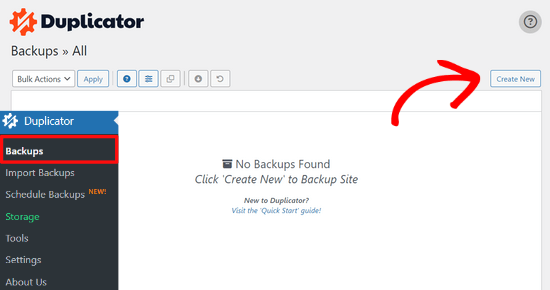
O Duplicator agora inicializará o assistente de retorno e atribuirá automaticamente um nome a esse pacote.
Clique no botão “Next” para continuar.

O Duplicator agora executará alguns testes para verificar se tudo está em ordem. Se o plug-in encontrar um problema, você verá um aviso com instruções.
Se todos os itens estiverem marcados como “Bom”, clique no botão “Construir”.

O plug-in começará a criar um pacote de duplicação dos arquivos do seu site. Dependendo do tamanho de seu site, esse processo pode levar alguns minutos.
Quando terminar, você verá a opção “Download”. Ao clicar nela, você verá as opções de download dos dois arquivos ou do instalador e do arquivo (zip) separadamente.
Escolha “Download Both Files” (Baixar ambos os arquivos) para baixá-los em seu computador.

O arquivo Archive é uma cópia completa de seus arquivos do WordPress. Ele inclui seus temas do WordPress, configurações de permalink, plug-ins, uploads e quaisquer outros arquivos criados pelos plug-ins do WordPress.
O script do instalador é um arquivo PHP que automatizará e executará a migração do WordPress ao descompactar o arquivo compactado.
Etapa 2: Crie um banco de dados para seu novo nome de domínio
Antes de mover seu site WordPress para o novo domínio, você precisará de um novo banco de dados SQL para descompactar o WordPress em seu novo nome de domínio.
Se você já tiver criado um banco de dados, poderá pular esta etapa.
Para criar um banco de dados, acesse o painel cPanel da sua conta de hospedagem, role para baixo até a seção “Databases” (Bancos de dados) e clique no ícone“MySQL Databases“(Bancos de dados MySQL).
Mostraremos como localizá-lo no Bluehost, mas as instruções básicas são as mesmas e devem se aplicar a todos os provedores de hospedagem.
Faça login no painel de controle da sua conta Bluehost e clique no botão “Settings” (Configurações) abaixo do seu site.
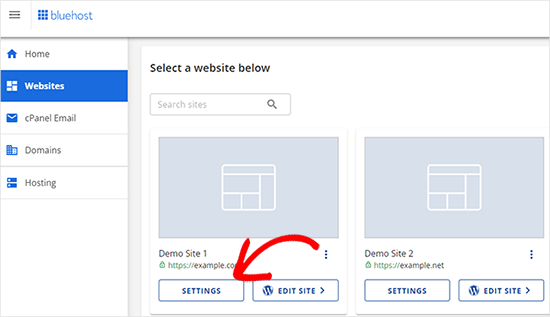
Nas configurações do seu site, você precisa mudar para a guia “Avançado”.
Role um pouco para baixo até a seção cPanel e clique em “Manage” (Gerenciar).
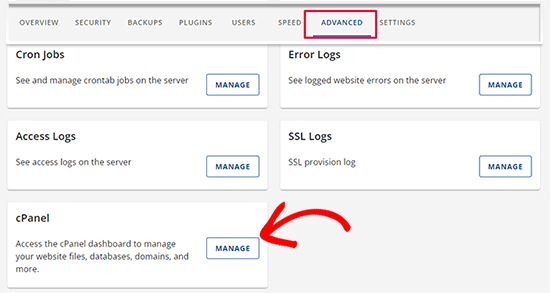
Isso abrirá o painel do cPanel.
Role para baixo até a seção Bancos de dados e clique na opção “Bancos de dados MySQL”.
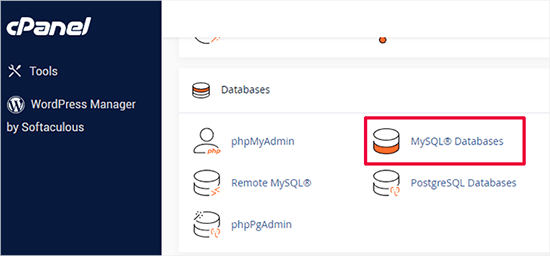
Observação: o painel de controle da sua hospedagem pode parecer um pouco diferente das capturas de tela. No entanto, você ainda deve encontrar uma seção Databases (Bancos de dados) com uma opção para criar um novo banco de dados.
Basta fornecer um nome para o seu banco de dados e clicar no botão “Create Database” (Criar banco de dados).
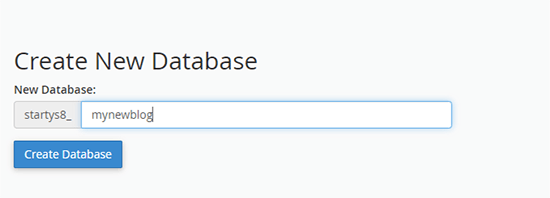
O cPanel criará um novo banco de dados para você. Depois disso, você precisa rolar para baixo até a seção Usuários do MySQL.
Em seguida, forneça um nome de usuário e uma senha para o novo usuário e clique no botão “Create User” (Criar usuário). Não se esqueça de anotar o nome de usuário e a senha em um local seguro.
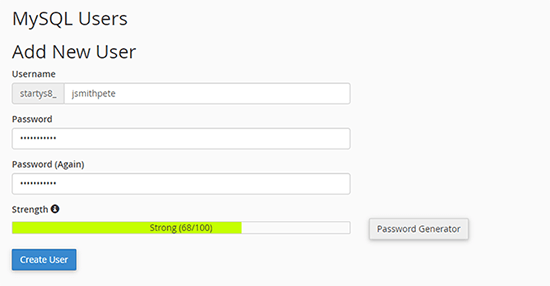
O novo usuário que você acabou de criar ainda não tem permissão para trabalhar no banco de dados. Vamos mudar isso.
Role para baixo até a seção “Add User to Database” (Adicionar usuário ao banco de dados). Primeiro, selecione o usuário do banco de dados que você criou no menu suspenso ao lado do campo “User” (Usuário). Em seguida, selecione o novo banco de dados que acabou de criar e clique no botão “Add” (Adicionar).
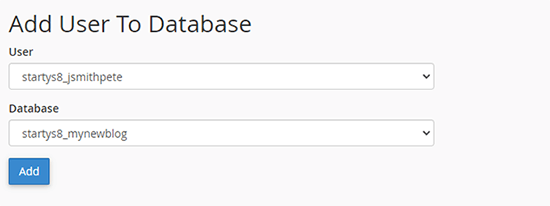
Em seguida, será solicitado que você escolha os privilégios para o usuário.
Selecione “All Privileges” (Todos os privilégios) e clique no botão “Make Changes” (Fazer alterações) para continuar.
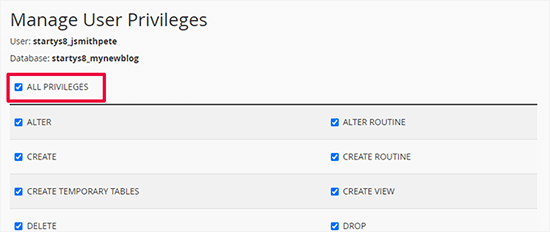
Seu banco de dados agora está pronto e pode ser usado para mover o WordPress para o novo nome de domínio.
Não se esqueça de anotar o nome do banco de dados, o nome de usuário e a senha. Você precisará dessas informações na próxima etapa.
Etapa 3: Descompacte o WordPress em seu novo nome de domínio
Agora, você precisa fazer o upload dos arquivos do Duplicator que baixou anteriormente para o seu novo nome de domínio.
O pacote do Duplicator também inclui sua instalação do WordPress. Isso significa que você não precisa instalar o WordPress em seu novo domínio.
Primeiro, conecte-se ao seu nome de domínio usando um cliente FTP. Uma vez conectado, certifique-se de que o diretório raiz de seu site esteja completamente vazio.
Depois disso, você pode carregar o arquivo e os arquivos do instalador no diretório raiz. Esse diretório geralmente é chamado de public_html.
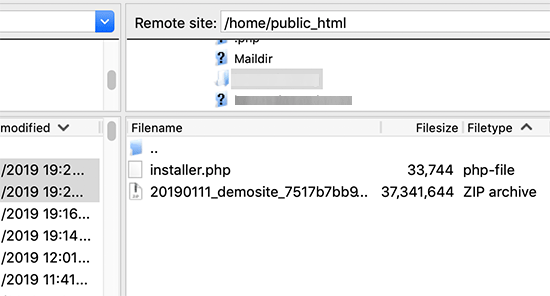
Quando os dois arquivos tiverem sido carregados, você estará pronto para descompactar o WordPress.
Abra uma nova guia do navegador e acesse o seguinte URL:
http://example.com/installer.php
Não se esqueça de substituir example.com por seu novo nome de domínio. Isso iniciará o assistente de migração do Duplicator.
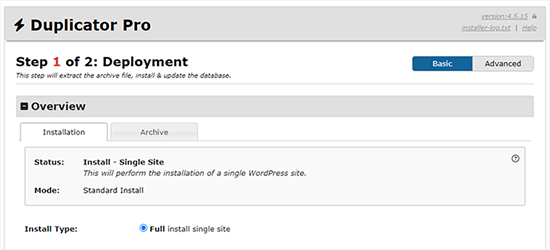
O instalador procurará o arquivo e, em seguida, selecionará automaticamente as opções para você na tela.
Role um pouco para baixo para inserir as informações do banco de dados que você criou na etapa anterior.
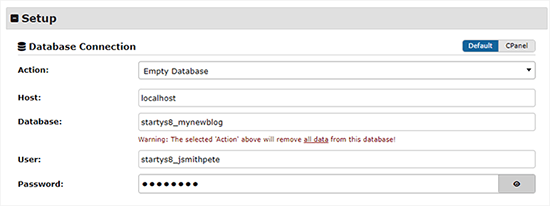
Em seguida, o Duplicator mostrará automaticamente o URL do seu domínio antigo e do seu novo domínio.
Se tudo estiver correto, clique no botão “Validate” (Validar) para continuar.
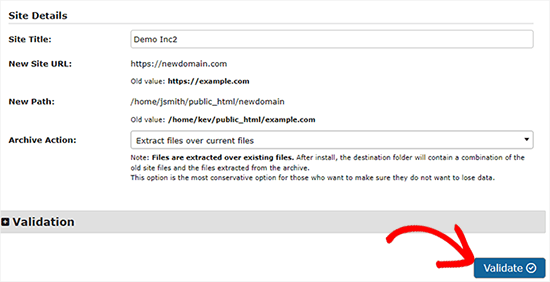
O Duplicator tentará se conectar ao banco de dados usando as informações que você forneceu.
Se for bem-sucedido, ele mostrará um Validation Pass. Caso contrário, será exibido um aviso com detalhes sobre como corrigir o problema.
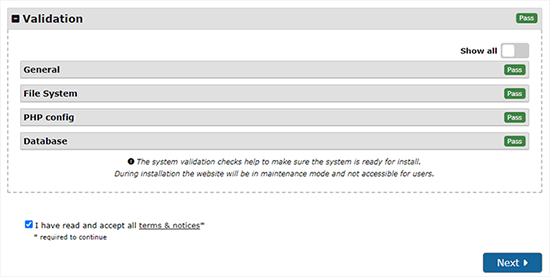
Clique no botão “Next” para continuar.
O Duplicator começará agora a importar seu site WordPress. Quando terminar, você verá uma mensagem de sucesso com um botão de login de administrador.
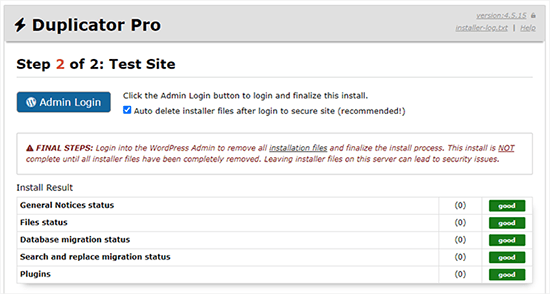
O Duplicator atualizará automaticamente os URLs para seu novo nome de domínio. Agora você pode clicar no botão “Admin Login” para concluir as próximas etapas.
Etapa 4: Configurar redirecionamentos 301 permanentes
A próxima etapa é direcionar os usuários que chegam ao seu nome de domínio antigo para o novo domínio. Isso é feito com a configuração de redirecionamentos 301.
Os redirecionamentos 301 são muito importantes para SEO e experiência do usuário. Ao adicioná-los, você poderá redirecionar automaticamente os usuários e os mecanismos de pesquisa para o seu novo nome de domínio.
Em outras palavras, sempre que alguém acessar um post ou uma página em seu domínio antigo, essa pessoa será automaticamente redirecionada para o mesmo post ou página em seu novo domínio, em vez de ver um erro 404.
Para manter os redirecionamentos em vigor, você precisará manter a instalação antiga do WordPress ativa para que ela possa continuar a redirecionar para a nova instalação que você acabou de criar.
Há duas maneiras de configurar os redirecionamentos. O primeiro método é fácil e requer apenas alguns cliques. O segundo método exige que você edite os arquivos manualmente.
Método 1: Configurar redirecionamentos 301 com o All in One SEO
Para esse método, você precisará do All in One SEO (AIOSEO). Ele é o melhor plugin de SEO para WordPress do mercado e permite que você otimize facilmente seu site WordPress para SEO.
Primeiro, você precisa instalar e ativar o plug-in All in One SEO em seu domínio antigo. Para obter mais detalhes, consulte nosso guia passo a passo sobre como instalar um plug-in do WordPress.
Observação: você precisará pelo menos da versão Pro do plug-in para acessar o complemento do gerenciador de redirecionamento. Você também pode configurar o AIOSEO em seu novo site do WordPress para aumentar ainda mais as classificações e o tráfego do mecanismo de pesquisa.
Após a ativação em seu domínio antigo, você precisa visitar a página All in One SEO ” Redirecionamentos e clicar no botão “Ativar redirecionamentos”.
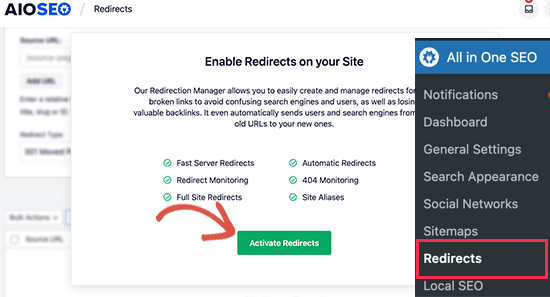
Em seguida, você precisa mudar para a guia “Full Site Redirect” e ativar a opção “Relocate Site”.
Depois disso, você precisa inserir seu novo nome de domínio ao lado da opção “Relocate to domain”.
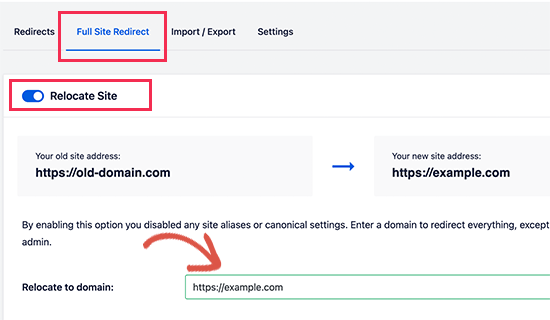
Não se esqueça de clicar no botão “Save Changes” (Salvar alterações) para armazenar suas configurações.
Método 2: Configurar manualmente os redirecionamentos para o novo domínio
Esse método exige que você edite o arquivo .htaccess do WordPress em seu nome de domínio antigo.
Primeiro, você precisa se conectar ao site antigo usando FTP e editar o arquivo .htaccess.
Ele estará localizado no mesmo diretório que a pasta wp-includes ou wp-admin. Abra o arquivo .htaccess e cole as seguintes linhas de código na parte superior:
1 2 3 | #Options +FollowSymLinksRewriteEngine onUnchanged: RewriteRule ^(.*)$ http://www.newsite.com/$1 [R=301,L] |
Certifique-se de substituir newsite.com por seu novo domínio no código acima.
Depois de aplicar essas alterações, acesse seu nome de domínio antigo. Ele deverá redirecioná-lo automaticamente para o novo domínio.
Se isso não acontecer, significa que o redirecionamento não está configurado corretamente e seu servidor provavelmente não oferece suporte a regras de redirecionamento. É necessário entrar em contato com a equipe de suporte da sua empresa de hospedagem na Web para ativar o RewriteEngine.
Etapa 5: Notifique o Google sobre seu novo domínio
Agora que você transferiu o WordPress para um novo nome de domínio e configurou os redirecionamentos, é hora de notificar o Google sobre sua mudança de endereço. Isso ajudará o Google a encontrar rapidamente o domínio do seu novo site e a começar a exibi-lo nos resultados de pesquisa.
Primeiro, você precisa se certificar de que o domínio novo e o antigo sejam adicionados ao Google Search Console como duas propriedades diferentes. Consulte a etapa 1 do nosso guia do Google Search Console para obter instruções.
Em seguida, você precisa selecionar o nome de domínio antigo como a propriedade ativa no painel da sua conta do Google Search Console.
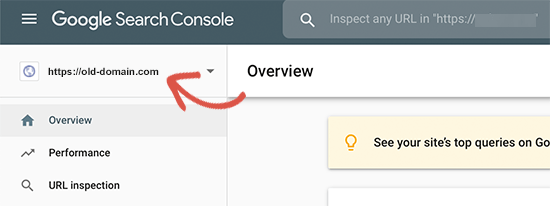
Depois disso, clique no menu Settings (Configurações) na coluna da esquerda.
Agora, você pode clicar na ferramenta “Change of address” (Mudança de endereço).
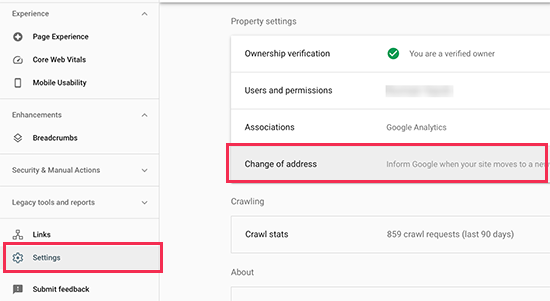
Agora, você precisa selecionar seu novo domínio na seção Update Google.
Em seguida, você deve clicar no botão “Validate & Update” (Validar e atualizar).
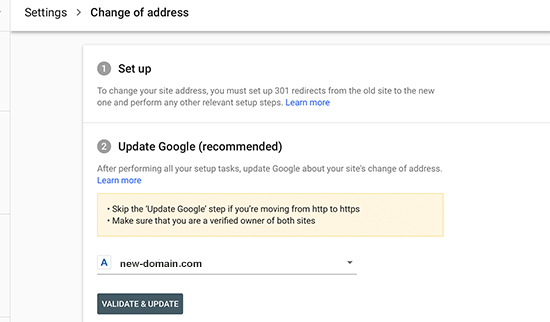
Isso é tudo. O Google agora validará que seu domínio antigo está sendo redirecionado para o novo domínio e salvará suas alterações.
Na próxima tela, o Google Search Console mostrará um assistente passo a passo para enviar sua solicitação de alteração de endereço.
Notifique seus usuários sobre o novo nome de domínio
Embora os redirecionamentos 301 façam seu trabalho, é sempre bom fazer um anúncio público sobre a migração.
Você pode fazer isso simplesmente escrevendo uma postagem de blog sobre seu novo site e compartilhando-a em suas contas de mídia social.
Se você tiver um boletim informativo por e-mail ou assinantes de notificações por push, deverá enviar um anúncio para eles também.
Isso pode ser útil de várias maneiras.
Em primeiro lugar, é mais provável que seus usuários se lembrem do novo domínio depois de lerem sobre ele.
Em segundo lugar, você pode pedir aos usuários que o informem se encontrarem algum erro. Você não pode testar seu site sozinho em todos os tipos de navegadores ou ambientes de sistema, portanto, é sempre útil ter um novo par de olhos para analisá-lo.
Tutorial em vídeo
Recursos de bônus
Os artigos e tutoriais a seguir o ajudarão a rastrear e recuperar suas classificações de SEO após a migração para um novo nome de domínio:
- A lista de verificação definitiva de migração de SEO para WordPress (para iniciantes)
- Como verificar se os posts do seu blog WordPress estão sendo classificados para as palavras-chave corretas
- Como rastrear os visitantes do seu site WordPress
- Dicas para otimizar suas postagens de blog para SEO como um profissional (lista de verificação)
Esperamos que este tutorial tenha ajudado você a mover seu site WordPress para um novo nome de domínio. Talvez você também queira ver nosso guia sobre como obter um domínio de e-mail gratuito ou seguir as etapas do nosso guia completo de SEO para WordPress.
Se você gostou deste artigo, inscreva-se em nosso canal do YouTube para receber tutoriais em vídeo sobre o WordPress. Você também pode nos encontrar no Twitter e no Facebook.





WPBeginner Staff
We are not sure about this option, we haven’t tried it ourselves so we can not recommend it. Any redirection you set up needs to be 301 so that search engines can update the new location.
vikramforever
I have my domain with godaddy and they have redirect option with match path mentioned on their help page – http://support.godaddy.com/help/article/5120/redirect-urls-with-your-hosting-account.
Is this a feasible option when i transfer my active site to another domain? As per the option in the post, i need to maintain the hosting for my old domain till the time i want the redirects to work. Using redirect with the ‘match path’ option will do away the need to do so. But i want to be sure that this is an option which works the same way the script (as you mentioned) works.
Keely Worth
Excellent – makes the process of moving a WordPress site a breeze. Thanks.
Ayman
I’ve just migrate a website site from one URL to another. I would really like to thank you for this great post. 100% working and a very simple instructions
Anas Khan
Nice post. I have few questions too,
I have 2 blog on WordPress. The new blog is active and i have 45 posts in my new blog. The old blog has 192 posts and all posts are index on google.
Now i want to transfer and publish all old 192 posts to my new blog so all posts can me view on my new blog. If i trash all posts from my old blog, remove the sitemap and webmaster tool of old blog and after 30 days i publish old posts to new blog using Add new post button then it works ? Is it considered a duplicate content ?
WPBeginner Support
You can simply import those posts to your new blog and set up a 301 redirection on your old posts on a post by post basis.
Admin
Mohammed Saimon
Yes its a nice post. Thanks to the author.
Vinish Garg
This is an excellent post and gave me some new direction for moving my WP blog from one domain to another. I will appreciate if you can correct me if I am wrong in planning it as below.
– I know hostgator and I understand how to use File Manager and setup WP, database and import/export database (xml files)
– My current WP blog is at: http;//www.example.com, and I want to move it to another domain http://www.example.org.
– One, I will setup new WP at new domain’s root (database, config file, custom theme, and import data file from old site)
– The new site will show the site exactly like old site, BUT only difference is the URL (because of new domain).
If everything is correct this far… I am not sure how to use redirects for all my old domain’s pages/posts to new domain. Can you please advise?
WPBeginner Support
You can do that by following the step 3 of this guide, setting up 301 redirects.
Admin
Stefan
Great post, unfortunately I have read it too late and have already moved my domain. All I have done is I have purchased a new domain for my blog (, before it was it’s still active for another 2 months). I have changed the WordPress URL and Site Address in wordpress general settings and resubmitted the sitemap with the new URL. That’s all I have done.
This was one month ago and since then the traffic is now totally down, from more than 1,000 pageviews a day to now not even 200.
If I google search “thailand redcat” not even one of my pages shows up. The sitemap however has successfully been submitted:
2:51:35pmStefan
Do you know what could be the reason for this and how can I solve the problem and get the search results and eventually traffic back to normal again?
Any help would greatly be appreciated. Cheers!
WPBeginner Support
Stefan, we are not sure we understand the process you followed to move your site to a new domain. Here are some general tips. First make sure search bots are able to crawl and index your site? Check your site in Google webmaster tools for crawl errors.
Admin
Charlie
I have the same problem. Google crawlers find a 500 error on the whole site since is did the migration. I tried on 2 different environments/providers, different php versions, I tried to deactivate/reactivate all my plugins one by one, I tried to regenerate the permalinks, the htaccess, the robots.txt… nothing works.
Mr Joy
Thank you for your great post. I followed your post and moved my site to new domain. It’s all working fine but there is only one problem in my site regarding WordPress visual editor. The problem is “When I upload an Image on any post by Add Media option, then click on the picture thumble “edit image” an iFrame come with a Not Found Error. But when click delete it works fine. Please help me to resolve the problem. Check the screenshot : http://bit.ly/1fqjE1b
WPBeginner Support
The first thing you can try is to update your permalinks, simply go to Settings » Permalinks and click on the save changes button.
Admin
AP
Excellent work – thanks very much! It might be helpful to add the reply above – the one dealing with new database creation and use – to the initial instructions, as not everyone will read the comments before attempting a transfer.
Gary Kirwan
Great article. My question is I use the affiliate cloaking method recommended by Yoast, which means I have a .htaccess file under a folder called /out/
Would I need to add the same 301 redirect code mentioned in the article to both .htaccess files in the root directory and affiliate links sub-folder? Does adding the 301 redirect code to the root directory .htaccess file only automatically cover the sub-folders one?
My goal is to make sure that external affiliate links work correctly as well.
Kingsley
Great tutorial, will be using it to Migrate http://www.ideacrunch.org to http://technblogging.com in the next few days but i have a question to ask. The database password and username name will it be the same as the old site?
Craig
Hi, appreciate this is a little late. But i literally just want to move from http://www.unlockworldtv.co.uk to http://www.unlockworldtv.com is this tutorial suitable for that? I am not moving hosts, just changing the url
WPBeginner Support
Yes it is.
Admin
Craig
Thanks. I’m stuck at the go to newsite.com/installer.php I just get my old site but with 404. I didn’t install wp in the new directory, just created an empty directory to put the installer and zip in. I am pointing my new domain from the registrar account to that new directory with my web host but not getting anything but the theme and 404. Any obvious tips?
Craig
just FYI i resolved this. It appears to be an issue with 1&1 (no surprise) but can be resolved by having an index.html file present. So for anyone on 1&1 adjust step 2 from
“Make sure that the root directory, or the directory where you want to copy your website is completely empty.” to “Make sure that the root directory, or the directory where you want to copy your website is completely empty except for installer.php, the .zip file AND an index.html page”
I believe this is to do with the way 1&1 prioritise pages on their server.
Denis Fitzgerald
Hi – Thanks for the article. I have a question: I am switching my site from Tumblr to WordPress. It has its own domain. I would like to know if the buttons at the end of each article showing social shares, Twitter, Facebook, Google+, will maintain the original share count or go back to zero. Thank you.
WPBeginner Support
If its the same domain and your URL structure remains intact, then hopefully you will be able to retain those social counts.
Admin
Bertjan
Excellent guide! Thank you very much.
Sudha Mathew
Hi, I moved my site using redirects about 6 months ago and it works fine. I need to renew my contract with web security company soon. So I need to know how much traffic is still getting redirected from the old site. Could you explain how to do that? I am not tech savvy but can use both Webmaster tools and Google Analytics.Thanks in advance!
Best
Sudha
Moti
Hello,
I would like to change the domain name of my site (staying on the same host).
In the instructions above it is indicated that I should “make sure that the root directory, or the directory where you want to copy your website is completely empty.”.
In my case the WP is installed in the root directory (I have the wp-content folder under public-html) – I assume that this means that my WP is installed under the root directory.
Which folders should I clean / delete before I run the installed file generated by the duplicator ?
Thanks,
Moti.
Declan
Thank you for the tutorial. Worked great with no problems whatsoever.
I do, of course, have a question regarding SEO.
My old site wasn’t registered in Google webmaster tools, so obviously there’s no option to let them know about the changes I’ve made. My question is: Will I need to register my old domain with Google webmaster tools first, and then my second domain…and then notify them abut the changes?
Any thoughts would be great.
Thanks again for the article, it was extremely helpful.
Declan.
WPBeginner Support
Yes, you will have to notify about the change on your old site’s webmaster tools account. However, this is just the fastest way to do it. If you have setup your 302 redirects then search engines would pick that up as well.
Admin
reza
hi,
this works just great, i redirect my old.com which is my main domain to new.com which is an addon domain (in the same hosting)
but when i added another new addon domain, it makes my new addon domain can’t be accessed….it always redirect my addon.com to new.com/addon.com…
can you help ??
Jennifer @ Delicieux
Thank you for explaining this in so much detail. I have a question though. I’ve been thinking about moving to a new domain name for some time, but I wanted to know if I would have any issues given the fact that earlier in the year I changed the permalink structure on my old blog.
I followed the instructions on Yoast on how to change my permalink structure and edited my .htaccess file, and wonder if this will cause problems when I move to a new domain? This is the one thing that is holding me back because I don’t want things to screw up and lose rank and end up with broken links.
WPBeginner Support
you can transfer your old .htaccess file to your new site. If the .htaccess file has any references to the old domain name then replace those with the new domain name and your would be OK.
Admin
Hrayr
Hey,
First of all many thanks for this article – it worked great without any problem for me!
I have one simple question specific to my case, would highly appreciate your thoughts on this.
Basically i used this approach to copy my wordpress site from localhost to the host/domain from 3rd party.
As said all worked ok – i just want to make sure that this approach doesn’t leave any old urls/links/references that can “annoy” google to crawl this new site. My site is pretty basic, so in worst case scenario i can just recreate if there is any disadvantage of crawling/SEO when site is copied by duplicator.
Is there any known SEO issue of new site that you are aware of?
WPBeginner Support
We not aware of any SEO issues, but if you come across any you can inform the plugin author by opening a support thread on plugin’s page.
Admin
Kevin
I don’t think the way you suggest users do their 301 redirect is the best way. It’s well documented, even recommended by Google, that you do page-to-page redirects, NOT dump all your old website’s pages to the homepage of the new site. The htaccess code you provide does the latter. It isn’t a good way to preserve link juice.
Maybe you can refer us to a good htaccess tutorial instead? There are also online htaccess generators out there that can make it much faster to do page-to-page redirects.
WPBeginner Support
Kevin, you are right and rewrite rules in the article do exactly that. Instead of redirecting users to the homepage it sends them to the individual page. $1 at the end of code appends the link with the proper permalink structure.
Admin
Julian
Hi, when I’m doing this after ‘deploy’ it misses the ‘update’ section and reverts back to a 404 page at the old web address… any idea what could be causing this?
Many thanks!
Munna
Thank you very much for this post. I was in trouble redirecting my oldsite visitors to the new site. But your .htaccess code made it super easy because both sites were in the same hosting server.
Raspal
Hello,
I completed all the steps and the blog at the new site is up fine. But I can’t login to the admin area. I have two users, one is an admin user. I get this error when trying to login:
“ERROR: Cookies are blocked or not supported by your browser. You must enable cookies to use WordPress.”
I tried different browsers and also tried clearing any cookies. Also tried changing password. Password was changed fine but still getting the above error.
Can you please help ASAP?
Using WP version 3.7.1
Regards,
Raspal
Neil Bargas
Thanks man! 100% working and a very simple instructions.
Lynn
Fantastic article! You are my hero of the day.
Jahid
”Login to your new site’s WordPress admin using the same username and password that you had on the old site. Go to Settings » Permalinks in your new site’s WordPress admin and click on the save button.”
Once I login, it shows me the first step page ”Step 1: Files & Database” instead of showing the WP dashboard. Help!
WPBeginner Support
Seems like you need to update your wp-config.php file
Admin
Chrissy
Hi! Thanks so much for this helpful article – I’m in the process of running through the steps now.
My one question is:
I have my blog hosted at one domain, let’s call it http://www.reallylongdomainname.com/blog, but I have a redirect to forward it to my other domain: blog.shortername.com. I now want to migrate the blog to shortername.com/blog, because some of the links don’t work after the redirect.
All my posts and things already have permalinks at shortname.com/blog/post#, so do I really need to do any of this 301 stuff? Am I safe to skip steps 3, 4 & 5, or is there something I need to consider? And will I need to delete the old blog or just the redirect once I launch it at the new domain?
Would be really great to find out how to proceed, since I’ve tried dozens of things this week and no situation is quite the same as mine :/ Thanks!
WPBeginner Support
The purpose of 301 redirects is to not just redirect users but also let search engines know that you have moved to the new location so step 3 and 4 are a must otherwise it may affect your SEO rankings.
Admin
Mark P
Great post. One question though.
Let’s say someone clicks on a backlink for my website’s old domain. (Let’s call it olddomain dot com / blogpost1). Will this then redirect to the new domain’s respective link (newdomain dot com / blogpost1) instead of just redirecting to the new domain’s homepage?
WPBeginner Support
Yes, it would redirect users landing on your posts and pages on the old site to the posts/pages on the new site.
Admin
Mark P
Thank you!
Morgan
Question: I am switching my site from one host to a new host. At the same time, I am changing my domain name. I have already successfully transferred my WordPress site to my new host using the new domain name. I now am to step 3 and want to use 301 redirects to point those old URLs to the new site URLs. However, the old site is on the old host and I’m planning on getting rid of that site.
Will the 301 redirects still work? Or do I also need to move the old site over to my new host and THEN do the redirects? I’m a bit unsure what to do and would love any advice.
WPBeginner Support
If it is possible for you to keep the old site online for at least a month, then you can add 301 redirect. After that update your site’s information on Google Webmaster tools. Once you have recovered your search rankings and traffic you can then close your account with the old web host.
Admin
Nj
Thank you for the helpful posts, but sometimes with such plugins, a video will help A LOT. I hope you will consider this
Thanks again
Arnold
Hi. Could you please elaborate the part where you said “The installer will ask you to provide database information for the new site and check the box for Table removal?” Where do I find this database information? So should I check the box for Table removal? Thanks!
WPBeginner Support
This is the database where you will be importing your old site from the package you created earlier. Log into your web hosting dashboard, find phpmyadmin and create a new database. Come back to installer.php and provide the new database name, host, user and password.
Admin
Kara Lumsden
So you should not install wordpress on the root of the new domain? The only thing you need to do on the new domain is only create a new database, is that correct? Can you elaborate a little more on how to create the database in phpmyadmin?
So appreciative, thank you for all that you do!
WPBeginner Support
No it is OK to install WordPress on the root of the new domain. Yes, you just need to create a new database and the Duplicator takes care of the rest.
Kara Lumsden
Can you please provide instructions on how to create the database?
Thank you very much,
Kara
Dennis J. Smith
How long should one wait before deleting the old site?
WPBeginner Support
30 to 90 days, depends on how successful your move was. If you are confident that your new domain has gained nearly the same traffic as the old site, then you can delete it.
Admin
dyer
Hi ive encountered an issue. Im unable to save my Permalinks as I cant locate the WP admin file ive tried to upload the WP admin file again but this hasn’t the issue please could you advise me if there is any other steps I can take to rectify this issue.
Thanks
Dyer
WPBeginner Support
@dyer We are unable to understand your question. We are assuming that you can not access your WordPress Admin area. In that case, connect to your site using an FTP client like filezilla. Find the file
.htaccessdownload it to your hard disk and delete it from your website. Hope this resolves your issue.Admin
Fakhre
Thanks for the article guys!
I am hosting my site on Bluehost and just want to change the Domain name without loosing the SEO and backlinks.
My site contents is huge, i have about 8000 posts. Any solution for renaming the domain??
Sanjay Patel
Hello…
Really useful information but duplicator plugin is not working in my website. please solve my problem. how to do this?
Thanks in advance.
Dinah
Does this work with moving from one domain to a subdomain?
Editorial Staff
Yes
Admin
Dinah
Does this work for moving to a new subdomain? Like if my wordpress blog was on oldsite.com and I wanted it on blog.newsite.com, would I do the same thing?
Editorial Staff
Yes.
Admin
Emmie
I recently did this and the links and all redirected fine and dandy, however I just got slapped by Google with a penalty for instantly having so many backlinks – they think I bought them. Has anyone else encountered this? I made the appropriate notifications in Google Webmaster tools before moving, and it’s done nothing to help this. It’s hit me hard, so if anyone has experience in remedying this, please share!
Editorial Staff
Hey Emmie, where do you see that you get slapped for having too many backlinks? Does it show you that error in your Webmaster Tools? Just trying to see how did you come to the conclusion that you got penalized by google.
https://www.google.com/webmasters/tools/reconsideration << This is the page where you can send a reconsideration request to Google.
Admin
Lateef Adewale
Do you have any idea if this will work if i am moving a site from Bluehost to Wp Engine.
Editorial Staff
Yes it should work.
Admin
Emily
Just went through this whole process, worked perfectly and just what I needed to know. Thank you WPBeginner! The only glitch I ran into was my own fault – didn’t deactivate my security plugins first so I had to do it all over. Now, I am an expert… : )
Sandra Christie
Thanks for the article!
Are the steps for moving the same domain to a new host basically the same? And can that cause a drop in SEO as well?
Travis Pflanz
As well, the “Change of Address” option in Webmaster Tools is now in the Options menu at the top right in in Gear icon.
Zach Smith
Thanks for publishing another great article for us. This is best for any technology related blog.
Bob
Thanks–this is great information. I’m really excited to learn about Duplicator. While moving a domain is something I might have to do occasionally, I’m constantly cloning environments for development and testing purposes. The manual cloning process I’ve been using is time-consuming and potentially error-prone. Duplicator has the potentially to be a considerable improvement!
Sam
I just moved WP to a new domain and server using this method. Webmaster Tools now shows many 403 errors on the new server for each folder in uploads such as wp-content/uploads/2012/07 and one 403 error for each of the months. On my old server I did not get this. When moving the site should we also change or check the permissions? What should they be for the wp-content/uploads folder?
Editorial Staff
Google should not be indexing the folders rather they should be indexing the files inside of it. If you try to access the folder directly using a browser, WordPress will give you a 404 error. You don’t want to allow access to a directory that has no index page, which will then produce a directory listing that will get indexed and crawled, including the links to all files.
Admin
sam
Thanks for the reply. Then why does Google show a 403 error for the folders in webmaster tools. Does this not mean that something is wrong?
Zimbrul
THIS IS THE ARTICLE I WAS LOOKING FOR 1 YEAR NOW!!
Editorial Staff
Better late than never
Admin
Jasim Ahmed
Duplicator is great plugin but problem is its not work with some server as its need higher PHP version except this is there any other way to do ?
Editorial Staff
Yes, you can manually download the files and the database. Upload them on the new domain. Replace all the old url instances in the database using phpMyAdmin SQL search and replace query. The easier solution would be to ask your host why they are not on the higher versions of PHP or switch to a better host.
Admin
iAn
hi, I believe this won’t preserve your social network network sharing counters (number of shares and likes). Any idea how to retain those popularity meter?
Editorial Staff
You can’t retain the social counts because those go based on your canonical URLs which will be the new site (very important for SEO). The counters are mainly for social proof. All existing links in social media will properly redirect, so you won’t lose any traffic there.
Admin